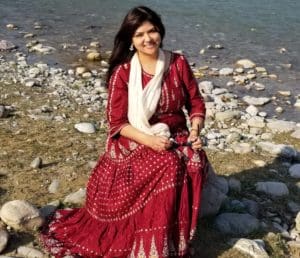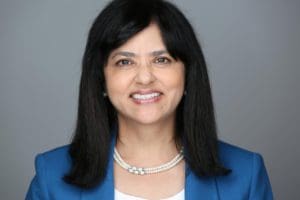The Fusion of Human Relationships, Mediation in Practice. Member Spotlight: Sunita Kumar
Sunita Kumar, based in South Carolina, is a trained mediator and commercial arbitrator, serving on the board of Mediation and Meeting Center of Charleston. In her role as mediator, Sunita also volunteers for the Upstate Mediation Center and Midlands Mediation Center. Though new to MBBI, Sunita has already made a lasting impression on the organization and has become immersed in new and emerging projects.
Preventing Violence Before it Begins
 Currently, within MBBI, Sunita is working on two projects. As a project coordinator for the Trust Network, Sunita is collaborating with MBBI partner organizations to create a first-of-a-kind early warning/ early response platform in the U.S. for preventing violence before, during, and after the 2020 U.S. presidential elections. However, her long-term vision for the platform is to have a system in place at the local level to prevent violence and to connect communities. This platform would ensure that people have a way to communicate and disseminate information to vulnerable communities when they sense there will be violence. Sunita explains that this system will “enable communities to find other ways of addressing issues so that they don’t lead to violence”.
Currently, within MBBI, Sunita is working on two projects. As a project coordinator for the Trust Network, Sunita is collaborating with MBBI partner organizations to create a first-of-a-kind early warning/ early response platform in the U.S. for preventing violence before, during, and after the 2020 U.S. presidential elections. However, her long-term vision for the platform is to have a system in place at the local level to prevent violence and to connect communities. This platform would ensure that people have a way to communicate and disseminate information to vulnerable communities when they sense there will be violence. Sunita explains that this system will “enable communities to find other ways of addressing issues so that they don’t lead to violence”.
Sunita’s other project is an MBBI working group on improving community-police relations. With this group, she hopes to look at practical applications for mediation and facilitative dialogue to enhance communication between the public and police. This project aims at “taking community and police relations to the next level, using the mediation concept of neutrality and applying it in both individual and community group situations, looking for ways to understand root causes and for all sides to move forward together”.
Building the bridge between people
Holding a Bachelor of Science degree in civil engineering from Duke University and a Masters of Science degree in environmental engineering from the University of Tennessee, Sunita became a civil engineer to help develop communities. Her main goal was to help those in need have access to clean water, roads, and electricity, and other infrastructure. However, when she recalls her experiences in the field, she is reminded of the importance of building infrastructure not only literally on the ground but figuratively in the society. Sunita explains, “I may have learned calculations behind building a bridge, but the calculations for building bridges between people are so much more complex”. Through her engineering, international project management, and business development career, she found herself mediating many conflicts. She realized she needed to gain more formal experience in mediation because “you will always be dealing with conflict, no matter what career you’re in, and you have to be able to transform conflict into value”. Her main inspiration for moving formally into mediation was to move from building infrastructure to helping address deep entrenched ethnic, religious, and class conflict.
“In engineering, you look at the ideal world”, she starts, “but the formulas must adapt to real-life situations. Mediation helps with this”.
The Rubix Cube Solution
When asked what her biggest training revelation was, Sunita responds: “I had this concept of what a mediator was; they came in and came up with a solution for the parties. But, they don’t come up with a solution, they help the parties surface the solution”. She clarifies that mediation is so vital in today’s climatic world because people have the opportunity to be a part of the process and reconnect in profound ways. She relates this to a Rubix Cube, turning and turning, and eventually, there will be a solution that everyone can live with, although it may not be perfect, it will be sustainable.
Art and Science of Mediation
 Mediation can be seen as the blending of art and science, Sunita illustrates. The art is guiding the conversation so that the science of the solutions can surface. As Sunita once worked in the nuclear industry, she explains that fusion, or the coming together of particles, is where the future of nuclear technology aspires to be. In contrast, fission is the way we get nuclear power today. She notes, “in fission, you’re taking things apart, and this also creates a lot of energy, but it can also be very negative. We have figured out how to do fission, but not fusion, which, like the sun, creates even more energy. We know how to pick each other apart, but not put each other together”.
Mediation can be seen as the blending of art and science, Sunita illustrates. The art is guiding the conversation so that the science of the solutions can surface. As Sunita once worked in the nuclear industry, she explains that fusion, or the coming together of particles, is where the future of nuclear technology aspires to be. In contrast, fission is the way we get nuclear power today. She notes, “in fission, you’re taking things apart, and this also creates a lot of energy, but it can also be very negative. We have figured out how to do fission, but not fusion, which, like the sun, creates even more energy. We know how to pick each other apart, but not put each other together”.
Sunita admits that it is never easy to help people to separate. It can be trying to remain neutral in a highly stressful and emotional environment for one or both parties, especially when people try to use their conflict to exert undue power or influence over the other party. But mediation can help people to realize where their concerns truly reside. Sunita believes in value optimization, to achieve the best possible outcome for both parties. To achieve this, she must, “be able to understand the cultural and individual context and how to phrase the questions that will allow the people to open up more fully”.
Sunita is enjoying getting to know the guiding foundations and principles of Mediators Beyond Borders International. She states, “I think there is a lot of leadership, vision, and excitement all around. The group is doing something that is actually having an impact, helping people, communities and governments around the world”. Concluding, Sunita remarks, “using mediation principles at the heart of the organization and then applying them in the U.S. and across the world in different formats and platforms, is really powerful”.
Article by Emily Shultis, MBBI Writer
